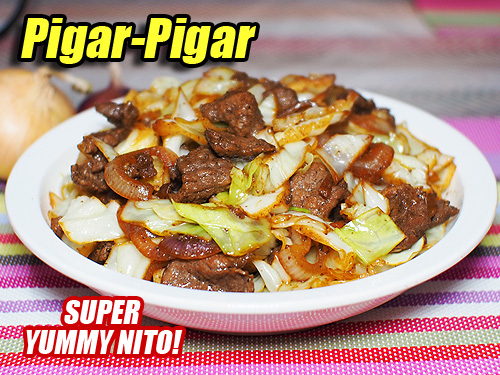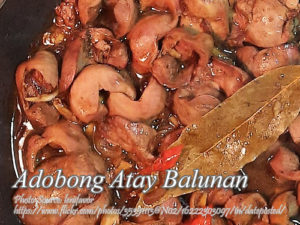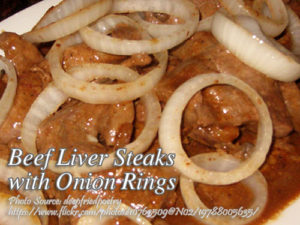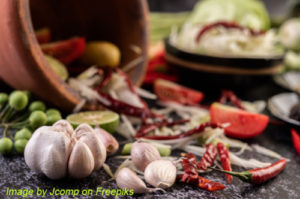Pigar pigar is a popular street food dish in Dagupan city. It is usually made with slices of carabao meat seasoned with salt and pepper. The way of cooking this popular dish might be taboo for others since it is deep fried for a few minutes then the cabbage and onions are also a deep fried. Way too much oil for the health conscious but since its a traditional dish and quite popular in that city so it does not matter too much. The meat is also mixed with liver sometimes.
Pigar pigar is a Pangasinan word which means “turning over”. It was actually derived from the process on how this dish was cooked, which is the constant turning over of meat while quickly deep-frying. Since carabao meat is not readily available in most parts of the country, beef is a good substitute for cooking this dish which is also used in this recipe.
Pigar Pigar: A Pangasinan Classic Worth Turning Over
If you’ve ever wandered through the streets of Dagupan City in Pangasinan, there’s a good chance you’ve encountered the mouthwatering aroma of the dish, a classic Filipino street food. This dish, known for its crispy slices of beef (or the more traditional carabao meat) and crunchy cabbage, has won hearts with its simplicity and flavor. Every bite of this delicacy speaks to the heritage and creativity of Pangasinan cooking, blending flavors that are both savory and satisfying.
In our family, it has become a go-to comfort food, especially during gatherings. I remember the first time my Tita Liza introduced me to it. “Don’t forget the constant ‘pigar-pigar’!” she’d say, smiling. In the Pangasinan dialect, “pigar pigar” means “to turn over,” aptly named after the way the meat is tossed repeatedly in hot oil. This method not only brings out the flavors but gives the dish its unique texture that makes it unforgettable.
The Origins and Significance of Pigar Pigar in Filipino Cuisine
Pigar pigar has humble beginnings in the carinderias, or small eateries, of Pangasinan. It started as a way to use affordable cuts of carabao meat, which is tougher and leaner compared to beef. As the dish grew in popularity, many vendors switched to beef, making it accessible to more people who craved this unique delicacy. Despite its deep-fried nature, it’s a sought-after comfort food for locals and visitors alike, with vendors preparing it fresh on the spot, where you can enjoy it hot and crispy.
As a traditional dish, it doesn’t shy away from oil. The meat, vegetables, and onions are all deep-fried in quick succession, then strained to create a crispy, well-seasoned result. For those watching their calories, it may seem a bit much, but the rich flavor and authentic experience make it worth the indulgence. For us, it’s a reminder that sometimes the tastiest things in life come from the simplest, most rustic processes.
Key Ingredients in Making the Iconic Dish
The main ingredients are thinly sliced beef, cabbage, and onions, but you might also find recipes calling for liver for added richness. Traditionally, carabao meat was used, but for convenience, beef is now more common and tender enough when cooked properly. Simple seasonings like soy sauce, black pepper, and oyster sauce are essential, marinating the meat and infusing it with flavor before frying.
When I asked my Tito Rene, who spent years in Pangasinan, what makes pigar pigar special, he said, “It’s not just the ingredients—it’s the way you keep turning the meat, the ‘pigar-pigar,’ to get the right texture.” The turning process ensures the meat gets evenly cooked, a key to achieving its signature tenderness.
How to Cook Pigar Pigar: Simple Steps, Big Flavor
The process is straightforward but requires attention to detail. First, the beef is sliced as thinly as possible, which helps it cook quickly and stay tender. Marinating it in liquid seasoning, soy sauce, and oyster sauce allows the flavors to meld, giving the meat a deeper taste. The key here is to let it marinate for an hour if you have the time—this adds to the depth of flavor.
After marinating, a generous amount of oil is heated in a pan, enough for deep frying. The marinated beef goes in first, sizzling as it hits the oil. During the frying process, it’s essential to keep turning the beef, just as the dish’s name suggests. The continuous movement ensures the beef cooks evenly, preventing any chewy bits and giving it that perfect crispiness.
Once the beef has cooked, cabbage and onions are added directly into the oil. This step is quick—just about a minute of stirring is enough for the vegetables to absorb the meat’s flavors while maintaining their crunch. The beef and vegetables are then scooped out with a strainer, and any excess oil is pressed out to leave only the delicious, crispy goodness behind.
Serving the Dish: Best Enjoyed Fresh and Hot
It is best served hot, straight from the pan. In Dagupan, you’ll see people enjoying it with a steaming bowl of rice, dipping each bite into a bit of spicy vinegar or soy sauce. In our family, we often add a side of calamansi to squeeze over the top, giving it a hint of tanginess that balances the richness of the fried meat.
My cousin Joy, who makes a mean dish, always says that it doesn’t feel complete without sharing it with family. She often serves it at weekend gatherings, where it’s not just a meal but a conversation starter. “Pigar pigar is all about sharing,” she says. And I agree—there’s something about the communal experience of sharing this dish that makes it taste even better.
Food for Thought: The Appeal of the Dish Across Generations
Why has it become a beloved staple not only in Pangasinan but also among Filipinos across the country? Perhaps it’s the simplicity of the dish, paired with the nostalgic flavors that remind us of home-cooked meals and street food adventures. Or maybe it’s the cooking process itself, a practice that has been passed down through generations.
For beginners, it is a fantastic introduction to Filipino street food culture. It’s approachable yet satisfying, with basic ingredients and minimal cooking techniques. As you savor each bite, it’s easy to imagine yourself in the bustling streets of Dagupan, surrounded by the sights and smells of this vibrant region.
In the end, pigar pigar is more than just fried meat and veggies. It’s a celebration of Filipino culinary traditions, a comforting dish that brings people together, and a reminder that sometimes, the most unforgettable flavors are born from the simplest ingredients and the warmth of family gatherings.
Ready to bring a taste of Pangasinan to your kitchen? Give this recipe a try, and let us know how it turns out! We’d love to hear your thoughts, tips, or any family twists you added—leave a comment below or share your experience with us!
How to Cook Pigar Pigar
Ingredients
- 1/2 kilo sirloin beef or carabeef (sliced thinly)
- 2 pcs medium white onions sliced
- 2 cups cabbage cubed
- 4 Tbsp. soy sauce
- 2 Tbsp. oyster sauce
- 1 tsp liquid seasoning
- 1 tsp ground black pepper
- 2 cups cooking oil for deep frying
Instructions
How to Cook Pigar Pigar
- Slice the beef as thinly as possible in bite size pieces. This way you can be sure that the beef will not ne chewy when cooked.
- Slice the cabbage in cubes or squares.
- Put the beef in the bowl and add liquid seasoning, oyster sauce, soy sauce, and black pepper. Mix to coat the meat with the seasoning. Let is stand for an hour.
- Heat cooking oil in a frying pan and deep fry the marinated beef for 5 minutes. Stir the meat continuously while cooking.
- After 5 minutes. add the cabbage and onions and stir the veggies with the meat for 1 minute with continuous stirring and turning.
- After a minute scoop out the meat and veggies using a strainer. Let it drip the oil for a while and gently press it with a spatula to help drain the excess oil.
- Put a plate on top of the strainer and turn it upside down to transfer the meat and veggies in the plate.
- Serve it immediately while hot and serve with cooked rice.
Video
Notes
Cooking Tips of Pigar Pigar:
Slice the Beef Thinly for Tenderness
Thinly slicing the beef is essential for achieving the right texture. Thinner slices cook faster and more evenly, making the meat tender and easy to chew. Aim for bite-sized strips to avoid chewy bites and ensure a satisfying, melt-in-your-mouth experience.Don’t Skip the Marinade for Depth of Flavor
Marinating the beef in a mix of soy sauce, oyster sauce, and black pepper gives the meat a savory, well-rounded flavor. Letting the beef sit for an hour enhances this flavor, making each bite more delicious. This step may seem small, but it’s the secret to rich, authentic taste.Fry Quickly at High Heat for Crisp Texture
High heat is key to achieving the crispy finish that this dish is known for. Frying the meat quickly at high temperatures prevents it from becoming greasy and locks in flavor. The continuous turning keeps the beef evenly cooked and deliciously crunchy.





